KANCHANABURI
Kanchanaburi is one of the most beautiful provinces in Thailand with a varied landscape profuse with hills, jungles and waterfalls. It is well-known among War-historians and movie-buffs as the site of the notorious Death Railways and the Bridge over the River Khwae, and among archaeologists for its Neolithic burial grounds.
Kanchanaburi is about 128 kilometers west of Bangkok and can be reached in approximately two and a half hours by car along good roads. The town of Kanchaburi is located at the point where two tributaries, the Khwae Noi and Khwae Yai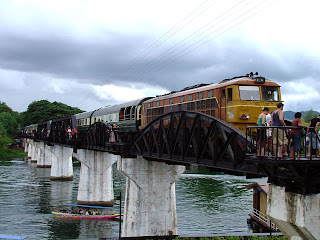 (which have their source in the Ta-Nao-Si Range) merge to form the Meklong River.
(which have their source in the Ta-Nao-Si Range) merge to form the Meklong River.
The present provincial capital is a relatively new town built by King Rama III in 1833. The old town was 18 kilometers away. On reaching Kanchanaburi a visitor should first stop at the TAT local office on Saeng-Chuto Road near the Bus Station to collect maps, folders and other useful information before starting out on a program of sight-seeing.
The famous Bridge over the River Khwae is located on the bank of Khae Yai river about four kilometers from the TAT office. It was brought from Java by the Japanese Army and was assembled at the River Khwae by allied prisoners of war. Bombed several times in 1945, it was rebuilt after the war. The curved spans of the bridge are the original sections. An estimated 16,000 prisoners of war and 49,000 forced laborers died during the construction of the bridge and the Death-Railway line that was to lead to Myanmar.
Kanchanaburi War Cemetery contains the remains of 6,982 war prisoners who lost their lives at the hands of the Japane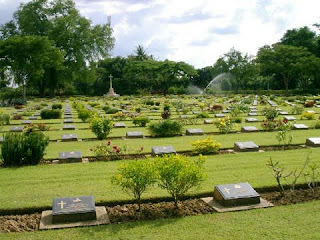 se Army during construction of the Death Railway.
se Army during construction of the Death Railway.
After invading Thailand in 1942, the Japanese brought British, Dutch, Australian and American prisoners up from Malaysia and Singapore. Forced laborers were also used to speed up construction of the railroad which was envisaged as an alternative to the sea route to Rangoon via Singapore and the Strait of Malacca which was vulnerable to allied ship and submarine attack.
The Chong-Kai Cemetery is smaller but more peaceful than the one in the town. It is also neatly kept with all kinds of beautiful flowers and hedges. It contains the remains of 1,750 prisoners or war. It can be reached by boats available at the pier in front of the town gate and also from the agent at the bridge.
Tham Khao Pan is a cave located about one kilometer from the Chong-Kai War Cemetery. It has a temple to the front. The cave housed many beautiful Buddha images in different postures. The stalactites and stalagmites are also interesting.
The JEATH War Museum comprises a reconstructed POW’s thatched detention hut. The raised bamboo bunks running the length of the long hut showing how each POW was allotted a meager living space. On the walls of the huts are posted actual, enlarged photographs and illustrations of the atrocities perpetrated against the prisoners, and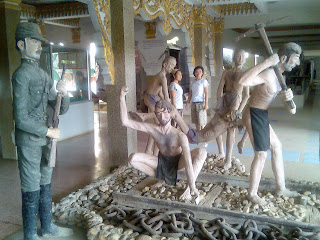 the appalling conditions under which they lived. JEATH stands for Japan, England, America, Australia, Thailand and Holland. The museum is on the bank of the Meklong River inside Wat Chai Chumphon.
the appalling conditions under which they lived. JEATH stands for Japan, England, America, Australia, Thailand and Holland. The museum is on the bank of the Meklong River inside Wat Chai Chumphon.
To reach the museum, turn left from the first intersection after entering Kanchanaburi town coming from Bangkok, turn left again to Park Phraek Road at the waterfront, and follow the road to the left, until reaching the first big monastery Wat Chai Chumphon on the river bank. The JEATH War Museum is at the entrance to the monastery.
Ban Kao National Museum is built near the Neolithic burial site discovered by a Dutch POW while working on the Death Railway. It is 35 kilometers out of town on a branch road off the Asian Highway. On display are specimens of Neolithic remains and utensils.
Some ten kilometers north of the Ban Kao Neolithic Museum is Prasat Muang Sing ruin, a historical park being renovated by the Fine Arts Department to display how the Khmer influenced architecture in this part of Thailand some 700-800 years ago. This is a must for archaeologists. The entrance fee is 20 baht.
Kandhanaburi Cultural Ceter was built by the Thai Farmers bank. The center offers an impressive collection of handicrafts, artifacts and historical exhibits that delineate the significant role played by this province in the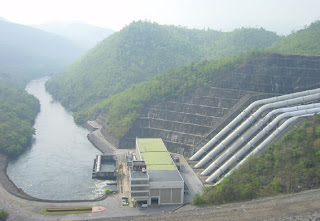 nation’s history. It is located inside the compound of Kanchanaburi Teacher’s College, just outside the town on Kanchanaburi-Saiyok Road.
nation’s history. It is located inside the compound of Kanchanaburi Teacher’s College, just outside the town on Kanchanaburi-Saiyok Road.
Wat Tham Mangkhon Thong is situated about four kilometers from the provincial capital on the bank of Meklong river. Once famous for its incredible floating nun, the temple is magnificently located in a cave high off the ground and reached by steps whose sides are carved in the form of dragon.
Somdet Phra Sri Nakharin Park is situated in Kanchanaburi Agriculture College, Tambon Nongya, about nine kilometers from the provincial city. This park is well-known locally as the Stone Garden or Stone Park since most of its area is scattered with stones in different sizes shaped like animals.
Hell Fire Pass in Aphoe Sai Yok was once part of the Death R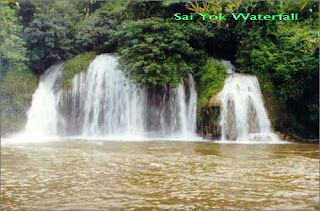 ailway. It is located near Kilometer marker 66 on the Sai Yok – thong Pha Phum Road and now abandoned.
ailway. It is located near Kilometer marker 66 on the Sai Yok – thong Pha Phum Road and now abandoned.
A classic Thai song has gained immortality for eulogizing the idyllic beauty of Sai Yok Falls on the bank of Khwae Noi River. Now part of the National Park, the falls are 104 kilometers from Kanchanaburi on the Asian Highway, which runs north from Kanchanaburi to its northernmost district Sangkhla on the Thai-Myanmar border. The entrance to the park is at Km 104 on the left. The Sai Yok Waterfalls are on the same side of the river. In order to get the full visual impact of the waterfalls, a new high-tensile wire-rope suspension bridge has been strung across allowing tourists to cross over for a view of the falls from the opposite side. Accommodation in the form of raft houses is also available near this bridge. Over on the other side is a sand bank from where Sai Yok Falls can be seen head-on and fully appreciated.
Nam Tok Khao Phang or Sai Yok Noi waterfall is about two kilometers from Nam Tok Station which marks the end of the Death Railway line. It is about 77 kilometers from Kanchanaburi town. A trip here is interesting for those who would like to follow the notorious Death Railway route. The countrys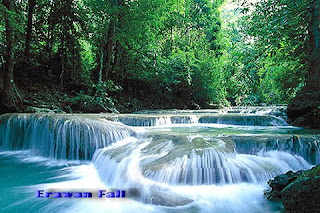 ide and the landscape are among the most beautiful in Thailand. During the dry season (September-April) the water level is too low to enjoy swimming and the best time for a visit is during the rainy season. There is a local bus service from town to the waterfall leaving every half an hour from 6.45 – 18.00 daily. The trip takes about two hours.
ide and the landscape are among the most beautiful in Thailand. During the dry season (September-April) the water level is too low to enjoy swimming and the best time for a visit is during the rainy season. There is a local bus service from town to the waterfall leaving every half an hour from 6.45 – 18.00 daily. The trip takes about two hours.
A boat ride to Tham Kaeng Lawa and NamTok Sai Yok is a delightful and adventurous experience that is hard to forget. This part of the Khwae Noi is rich with scenic beauty and wildlife abounds in the forest and near the river bank. Kaeng Lawa Cave is on interesting spot to visit being the biggest cave in the area and having wonderful stalactites and stalagmites. After visiting, you can continue to the enchanting Sai Yok Yai waterfall if time allows.
You can hire a boat from Pak Saeng Pier at Tam-Bon Tha Sao. A round trip will cost 1,000 – 1,200 baht per boat. Each boat can carry 10 – 12 persons. It takes about 2 ½ hours upstream to Sai Yok and 1 ½ hours back.
Erawan National Park at Amphoe Si Sawat, 65 kilometers from Kanchanaburi along Route 3199, is the site of the seven-tiered Erawan waterfall, widely regarded as being one of Thailand’s loveliest cascades. The 550 square-kilometer national park enjoys a mountainside forest setting with dense bamboo groves supporting a variety of bird species. The park’s other major attraction is the spectacular Phrathat Cave which contains monumental stalagmites. Bungalow accommodation and camping facilities are available.
national park enjoys a mountainside forest setting with dense bamboo groves supporting a variety of bird species. The park’s other major attraction is the spectacular Phrathat Cave which contains monumental stalagmites. Bungalow accommodation and camping facilities are available.
A bus to the park leaves from the bus terminal in Kanchanaburi near the TAT office every 50 minutes from 8.00-16.00. The trip takes about 1 ½ hours.
Five kilometers further up the road to the Erawan Falls lies the Si Nkharin Dam, a major hydro-electric power project. At the dam-site, a superbly planned complex of project buildings, personnel housing, recreation centers and guest residences blends incongruously the high rocky hillsides supporting the 300 foot high concrete dam.
A two hour boat trip on the vast reservoir from the Si Nakharin Dam brings you to the picturesque Huai Khamin waterfall (Nam Tok Huai Khamin) in Si Nakhrin National Park. The water cascades down the ochre limestone rock face inside the tree-lined bank on the hauntingly quiet shore of the reservoir. So remote, so much a part of jungle, so far away from civilization is this spot, that it seems the jungle will close back over the waterfalls, once the tour boat departs.
remote, so much a part of jungle, so far away from civilization is this spot, that it seems the jungle will close back over the waterfalls, once the tour boat departs.
Tham Than Lot is located 97 kilometers from Kanchanaburi in King Amphoe Nong Pru. There is regular bus service between Kanchanaburi and Ban Nong Pru, from where a mini-bus can be hired to reach the park. The park has beautiful caves – Tham Than Lot Noi, Tham Than Lot Yai and mighty waterfalls such as Nam Tok Than Thong. Tourists wishing to stay overnight at the park can make reservation by calling 579 0529, 579 4842.
The Khao Laem Dam hydro-electric dam is situated on the Khwae Noi river six kilometers, north of Amphoe Thong Pha Phum and about 147 kilometers north of the provincial city on highway 323. With a length and height of 1019 and 92 meters a great reservoir on which are many resorts in the form of raft houses.
river six kilometers, north of Amphoe Thong Pha Phum and about 147 kilometers north of the provincial city on highway 323. With a length and height of 1019 and 92 meters a great reservoir on which are many resorts in the form of raft houses.
Sangkhla Buri, some 225 kilometers from Kanchanaburi, edges the northernmost extremities of the reservoir. The scenic 70 kilometers route from Khao Laem largely parallels the reservoir, passing several raft complexes, roadside cascades, and vistas of partly-submerged trees crowding the reservoir banks.
The Three pagodas Pass, marking the border between Thailand and Myanmar at the northernmost point in Amphoe Sankhla Buri, is about 18 kilometers from Amphoe Thong Pha Phum. This sacred place was built in remembrance of an important battle. Near the pass, on the other side of the border, is a small Mon community with a market that attracts many tourists.
about 18 kilometers from Amphoe Thong Pha Phum. This sacred place was built in remembrance of an important battle. Near the pass, on the other side of the border, is a small Mon community with a market that attracts many tourists.
Wat Wang Vivegaram is a temple is situated on a hillside in Amphoe Sankhla Buri. It offer a wonderful view of the lake formed by the merging of three rivers. Wat Wang Vivegaram is well-known and respected, not only by Thai people, but also by many local tribal people such as Mons, Karens and Burmese. Its Pagoda was built in the style similar to Phra Phuttha Khaya in India and its temple houses a huge Buddha image made of marble.
Kanchanaburi is one of the most beautiful provinces in Thailand with a varied landscape profuse with hills, jungles and waterfalls. It is well-known among War-historians and movie-buffs as the site of the notorious Death Railways and the Bridge over the River Khwae, and among archaeologists for its Neolithic burial grounds.
Kanchanaburi is about 128 kilometers west of Bangkok and can be reached in approximately two and a half hours by car along good roads. The town of Kanchaburi is located at the point where two tributaries, the Khwae Noi and Khwae Yai
 (which have their source in the Ta-Nao-Si Range) merge to form the Meklong River.
(which have their source in the Ta-Nao-Si Range) merge to form the Meklong River.The present provincial capital is a relatively new town built by King Rama III in 1833. The old town was 18 kilometers away. On reaching Kanchanaburi a visitor should first stop at the TAT local office on Saeng-Chuto Road near the Bus Station to collect maps, folders and other useful information before starting out on a program of sight-seeing.
The famous Bridge over the River Khwae is located on the bank of Khae Yai river about four kilometers from the TAT office. It was brought from Java by the Japanese Army and was assembled at the River Khwae by allied prisoners of war. Bombed several times in 1945, it was rebuilt after the war. The curved spans of the bridge are the original sections. An estimated 16,000 prisoners of war and 49,000 forced laborers died during the construction of the bridge and the Death-Railway line that was to lead to Myanmar.
Kanchanaburi War Cemetery contains the remains of 6,982 war prisoners who lost their lives at the hands of the Japane
 se Army during construction of the Death Railway.
se Army during construction of the Death Railway.After invading Thailand in 1942, the Japanese brought British, Dutch, Australian and American prisoners up from Malaysia and Singapore. Forced laborers were also used to speed up construction of the railroad which was envisaged as an alternative to the sea route to Rangoon via Singapore and the Strait of Malacca which was vulnerable to allied ship and submarine attack.
The Chong-Kai Cemetery is smaller but more peaceful than the one in the town. It is also neatly kept with all kinds of beautiful flowers and hedges. It contains the remains of 1,750 prisoners or war. It can be reached by boats available at the pier in front of the town gate and also from the agent at the bridge.
Tham Khao Pan is a cave located about one kilometer from the Chong-Kai War Cemetery. It has a temple to the front. The cave housed many beautiful Buddha images in different postures. The stalactites and stalagmites are also interesting.
The JEATH War Museum comprises a reconstructed POW’s thatched detention hut. The raised bamboo bunks running the length of the long hut showing how each POW was allotted a meager living space. On the walls of the huts are posted actual, enlarged photographs and illustrations of the atrocities perpetrated against the prisoners, and
 the appalling conditions under which they lived. JEATH stands for Japan, England, America, Australia, Thailand and Holland. The museum is on the bank of the Meklong River inside Wat Chai Chumphon.
the appalling conditions under which they lived. JEATH stands for Japan, England, America, Australia, Thailand and Holland. The museum is on the bank of the Meklong River inside Wat Chai Chumphon.To reach the museum, turn left from the first intersection after entering Kanchanaburi town coming from Bangkok, turn left again to Park Phraek Road at the waterfront, and follow the road to the left, until reaching the first big monastery Wat Chai Chumphon on the river bank. The JEATH War Museum is at the entrance to the monastery.
Ban Kao National Museum is built near the Neolithic burial site discovered by a Dutch POW while working on the Death Railway. It is 35 kilometers out of town on a branch road off the Asian Highway. On display are specimens of Neolithic remains and utensils.
Some ten kilometers north of the Ban Kao Neolithic Museum is Prasat Muang Sing ruin, a historical park being renovated by the Fine Arts Department to display how the Khmer influenced architecture in this part of Thailand some 700-800 years ago. This is a must for archaeologists. The entrance fee is 20 baht.
Kandhanaburi Cultural Ceter was built by the Thai Farmers bank. The center offers an impressive collection of handicrafts, artifacts and historical exhibits that delineate the significant role played by this province in the
 nation’s history. It is located inside the compound of Kanchanaburi Teacher’s College, just outside the town on Kanchanaburi-Saiyok Road.
nation’s history. It is located inside the compound of Kanchanaburi Teacher’s College, just outside the town on Kanchanaburi-Saiyok Road.Wat Tham Mangkhon Thong is situated about four kilometers from the provincial capital on the bank of Meklong river. Once famous for its incredible floating nun, the temple is magnificently located in a cave high off the ground and reached by steps whose sides are carved in the form of dragon.
Somdet Phra Sri Nakharin Park is situated in Kanchanaburi Agriculture College, Tambon Nongya, about nine kilometers from the provincial city. This park is well-known locally as the Stone Garden or Stone Park since most of its area is scattered with stones in different sizes shaped like animals.
Hell Fire Pass in Aphoe Sai Yok was once part of the Death R
 ailway. It is located near Kilometer marker 66 on the Sai Yok – thong Pha Phum Road and now abandoned.
ailway. It is located near Kilometer marker 66 on the Sai Yok – thong Pha Phum Road and now abandoned.A classic Thai song has gained immortality for eulogizing the idyllic beauty of Sai Yok Falls on the bank of Khwae Noi River. Now part of the National Park, the falls are 104 kilometers from Kanchanaburi on the Asian Highway, which runs north from Kanchanaburi to its northernmost district Sangkhla on the Thai-Myanmar border. The entrance to the park is at Km 104 on the left. The Sai Yok Waterfalls are on the same side of the river. In order to get the full visual impact of the waterfalls, a new high-tensile wire-rope suspension bridge has been strung across allowing tourists to cross over for a view of the falls from the opposite side. Accommodation in the form of raft houses is also available near this bridge. Over on the other side is a sand bank from where Sai Yok Falls can be seen head-on and fully appreciated.
Nam Tok Khao Phang or Sai Yok Noi waterfall is about two kilometers from Nam Tok Station which marks the end of the Death Railway line. It is about 77 kilometers from Kanchanaburi town. A trip here is interesting for those who would like to follow the notorious Death Railway route. The countrys
 ide and the landscape are among the most beautiful in Thailand. During the dry season (September-April) the water level is too low to enjoy swimming and the best time for a visit is during the rainy season. There is a local bus service from town to the waterfall leaving every half an hour from 6.45 – 18.00 daily. The trip takes about two hours.
ide and the landscape are among the most beautiful in Thailand. During the dry season (September-April) the water level is too low to enjoy swimming and the best time for a visit is during the rainy season. There is a local bus service from town to the waterfall leaving every half an hour from 6.45 – 18.00 daily. The trip takes about two hours.A boat ride to Tham Kaeng Lawa and NamTok Sai Yok is a delightful and adventurous experience that is hard to forget. This part of the Khwae Noi is rich with scenic beauty and wildlife abounds in the forest and near the river bank. Kaeng Lawa Cave is on interesting spot to visit being the biggest cave in the area and having wonderful stalactites and stalagmites. After visiting, you can continue to the enchanting Sai Yok Yai waterfall if time allows.
You can hire a boat from Pak Saeng Pier at Tam-Bon Tha Sao. A round trip will cost 1,000 – 1,200 baht per boat. Each boat can carry 10 – 12 persons. It takes about 2 ½ hours upstream to Sai Yok and 1 ½ hours back.
Erawan National Park at Amphoe Si Sawat, 65 kilometers from Kanchanaburi along Route 3199, is the site of the seven-tiered Erawan waterfall, widely regarded as being one of Thailand’s loveliest cascades. The 550 square-kilometer
 national park enjoys a mountainside forest setting with dense bamboo groves supporting a variety of bird species. The park’s other major attraction is the spectacular Phrathat Cave which contains monumental stalagmites. Bungalow accommodation and camping facilities are available.
national park enjoys a mountainside forest setting with dense bamboo groves supporting a variety of bird species. The park’s other major attraction is the spectacular Phrathat Cave which contains monumental stalagmites. Bungalow accommodation and camping facilities are available.A bus to the park leaves from the bus terminal in Kanchanaburi near the TAT office every 50 minutes from 8.00-16.00. The trip takes about 1 ½ hours.
Five kilometers further up the road to the Erawan Falls lies the Si Nkharin Dam, a major hydro-electric power project. At the dam-site, a superbly planned complex of project buildings, personnel housing, recreation centers and guest residences blends incongruously the high rocky hillsides supporting the 300 foot high concrete dam.
A two hour boat trip on the vast reservoir from the Si Nakharin Dam brings you to the picturesque Huai Khamin waterfall (Nam Tok Huai Khamin) in Si Nakhrin National Park. The water cascades down the ochre limestone rock face inside the tree-lined bank on the hauntingly quiet shore of the reservoir. So
 remote, so much a part of jungle, so far away from civilization is this spot, that it seems the jungle will close back over the waterfalls, once the tour boat departs.
remote, so much a part of jungle, so far away from civilization is this spot, that it seems the jungle will close back over the waterfalls, once the tour boat departs.Tham Than Lot is located 97 kilometers from Kanchanaburi in King Amphoe Nong Pru. There is regular bus service between Kanchanaburi and Ban Nong Pru, from where a mini-bus can be hired to reach the park. The park has beautiful caves – Tham Than Lot Noi, Tham Than Lot Yai and mighty waterfalls such as Nam Tok Than Thong. Tourists wishing to stay overnight at the park can make reservation by calling 579 0529, 579 4842.
The Khao Laem Dam hydro-electric dam is situated on the Khwae Noi
 river six kilometers, north of Amphoe Thong Pha Phum and about 147 kilometers north of the provincial city on highway 323. With a length and height of 1019 and 92 meters a great reservoir on which are many resorts in the form of raft houses.
river six kilometers, north of Amphoe Thong Pha Phum and about 147 kilometers north of the provincial city on highway 323. With a length and height of 1019 and 92 meters a great reservoir on which are many resorts in the form of raft houses.Sangkhla Buri, some 225 kilometers from Kanchanaburi, edges the northernmost extremities of the reservoir. The scenic 70 kilometers route from Khao Laem largely parallels the reservoir, passing several raft complexes, roadside cascades, and vistas of partly-submerged trees crowding the reservoir banks.
The Three pagodas Pass, marking the border between Thailand and Myanmar at the northernmost point in Amphoe Sankhla Buri, is
 about 18 kilometers from Amphoe Thong Pha Phum. This sacred place was built in remembrance of an important battle. Near the pass, on the other side of the border, is a small Mon community with a market that attracts many tourists.
about 18 kilometers from Amphoe Thong Pha Phum. This sacred place was built in remembrance of an important battle. Near the pass, on the other side of the border, is a small Mon community with a market that attracts many tourists.Wat Wang Vivegaram is a temple is situated on a hillside in Amphoe Sankhla Buri. It offer a wonderful view of the lake formed by the merging of three rivers. Wat Wang Vivegaram is well-known and respected, not only by Thai people, but also by many local tribal people such as Mons, Karens and Burmese. Its Pagoda was built in the style similar to Phra Phuttha Khaya in India and its temple houses a huge Buddha image made of marble.
Hotels
Pung-Waan Resort Kwai Yai
Located on the river bank and only 2 kilometers from the Bridge Standard Room at Baht 2,825 1,560 nett/Room/Night incl. ABF.
Comsaed River Kwai Resort
Only 19 km. from downtown Kanchanaburi Garden View at Baht 2,500 2,160 nett/room/night incl. ABF
River Kwai Resotel
Location On the Bank of the River Kwai Noi on Saiyoke District Standard Chalet at Baht 2,184 nett/room/night ABF
Located on the river bank and only 2 kilometers from the Bridge Standard Room at Baht 2,825 1,560 nett/Room/Night incl. ABF.
Comsaed River Kwai Resort
Only 19 km. from downtown Kanchanaburi Garden View at Baht 2,500 2,160 nett/room/night incl. ABF
River Kwai Resotel
Location On the Bank of the River Kwai Noi on Saiyoke District Standard Chalet at Baht 2,184 nett/room/night ABF
Felix River Kwai Kanchanaburi
Located on the bank of the Kwai Yai River. SUPERIOR GARDEN VIEW at Baht 2,070 nett/Room/Night incl. ABF.
Momchailai Forest Retreat
Located on Thasao Saiyok Kanchanaburi Superior Room (2pax) at Baht 1,404 nett/room/night incl.ABF
Mission Hills Golf Club
Standard Room at Baht 1,440 nett/room/night with breakfast
Located on the bank of the Kwai Yai River. SUPERIOR GARDEN VIEW at Baht 2,070 nett/Room/Night incl. ABF.
Momchailai Forest Retreat
Located on Thasao Saiyok Kanchanaburi Superior Room (2pax) at Baht 1,404 nett/room/night incl.ABF
Mission Hills Golf Club
Standard Room at Baht 1,440 nett/room/night with breakfast
Other Hotels and Resorts in Kanchanaburi
Ban Huay Ulong
Baanrairimkwai Resort & Hotel
Baan Suan Fon Hotel
Boutique Raft Resort
Comsaed River Kwai Resort
Evergreen Hills Golf Club & Resort
Family Resort
Felix River Kwai Resort Kanchanaburi
Hintok River Camp @ Hell Fire Pass
Legacy River Kwai Resort & Seminar Center , The
Mission Hills Golf Club
Momchailai Forest Retreat
Monsane River Kwai Resort
Pavilion Rim Kwai Resort
Phatad Valley Hotel
Pongsuda Chalet
Pung-Waan Resort Kwai Noi
Pung-Waan Resort & Spa Kwai Yai
River Kwai Hotel
River Kwai Jungle Rafts , The
River Kwai Resotel
River Kwai Village
Royal Riverkwai Resort
R.S. Hotel
Siam Buri Resort
Xen Hideaway Resort [Formerly Kasalong Riverkwai]
Yoko Riverkwai Hotel & Resort
Ban Huay Ulong
Baanrairimkwai Resort & Hotel
Baan Suan Fon Hotel
Boutique Raft Resort
Comsaed River Kwai Resort
Evergreen Hills Golf Club & Resort
Family Resort
Felix River Kwai Resort Kanchanaburi
Hintok River Camp @ Hell Fire Pass
Legacy River Kwai Resort & Seminar Center , The
Mission Hills Golf Club
Momchailai Forest Retreat
Monsane River Kwai Resort
Pavilion Rim Kwai Resort
Phatad Valley Hotel
Pongsuda Chalet
Pung-Waan Resort Kwai Noi
Pung-Waan Resort & Spa Kwai Yai
River Kwai Hotel
River Kwai Jungle Rafts , The
River Kwai Resotel
River Kwai Village
Royal Riverkwai Resort
R.S. Hotel
Siam Buri Resort
Xen Hideaway Resort [Formerly Kasalong Riverkwai]
Yoko Riverkwai Hotel & Resort







